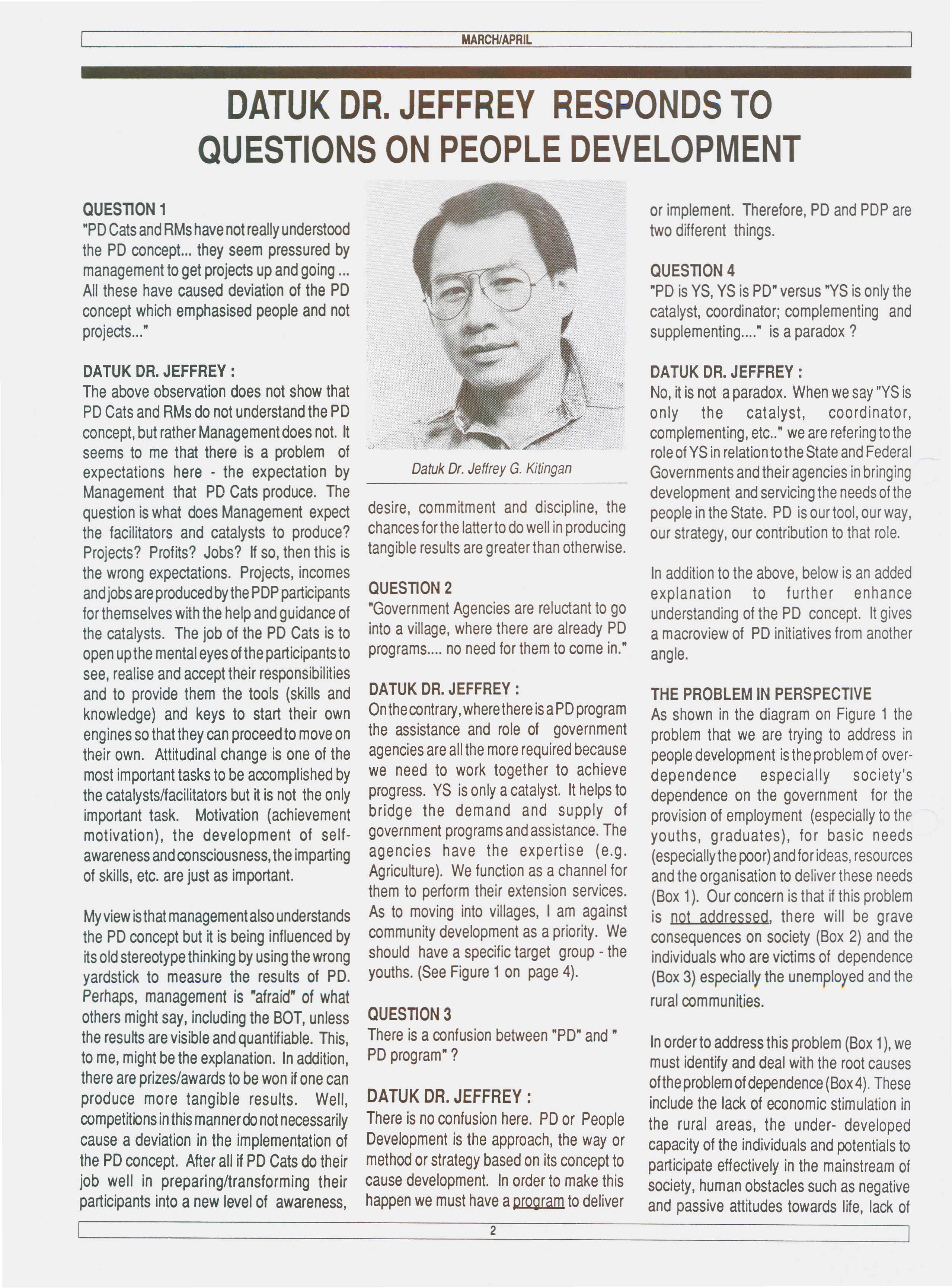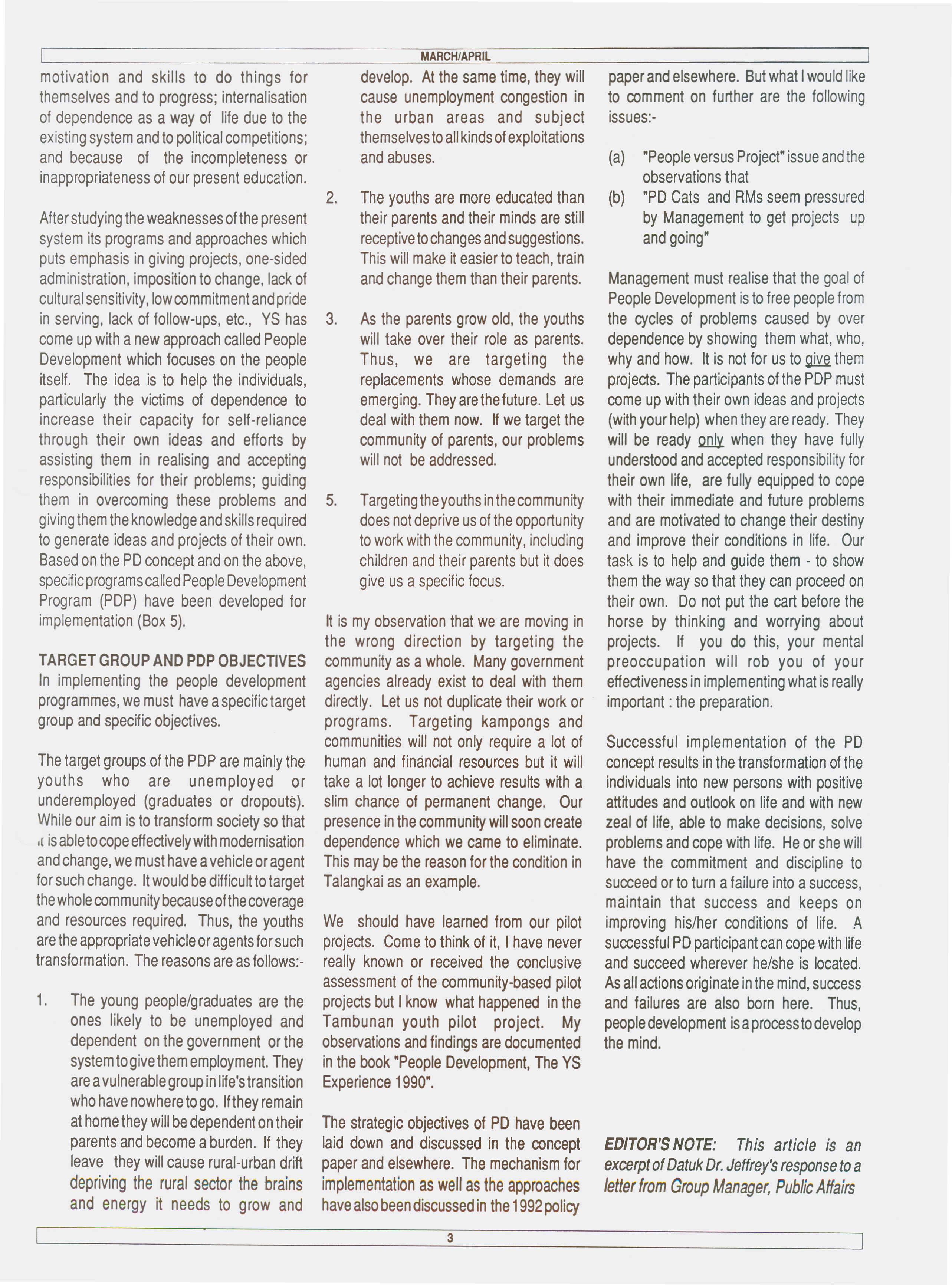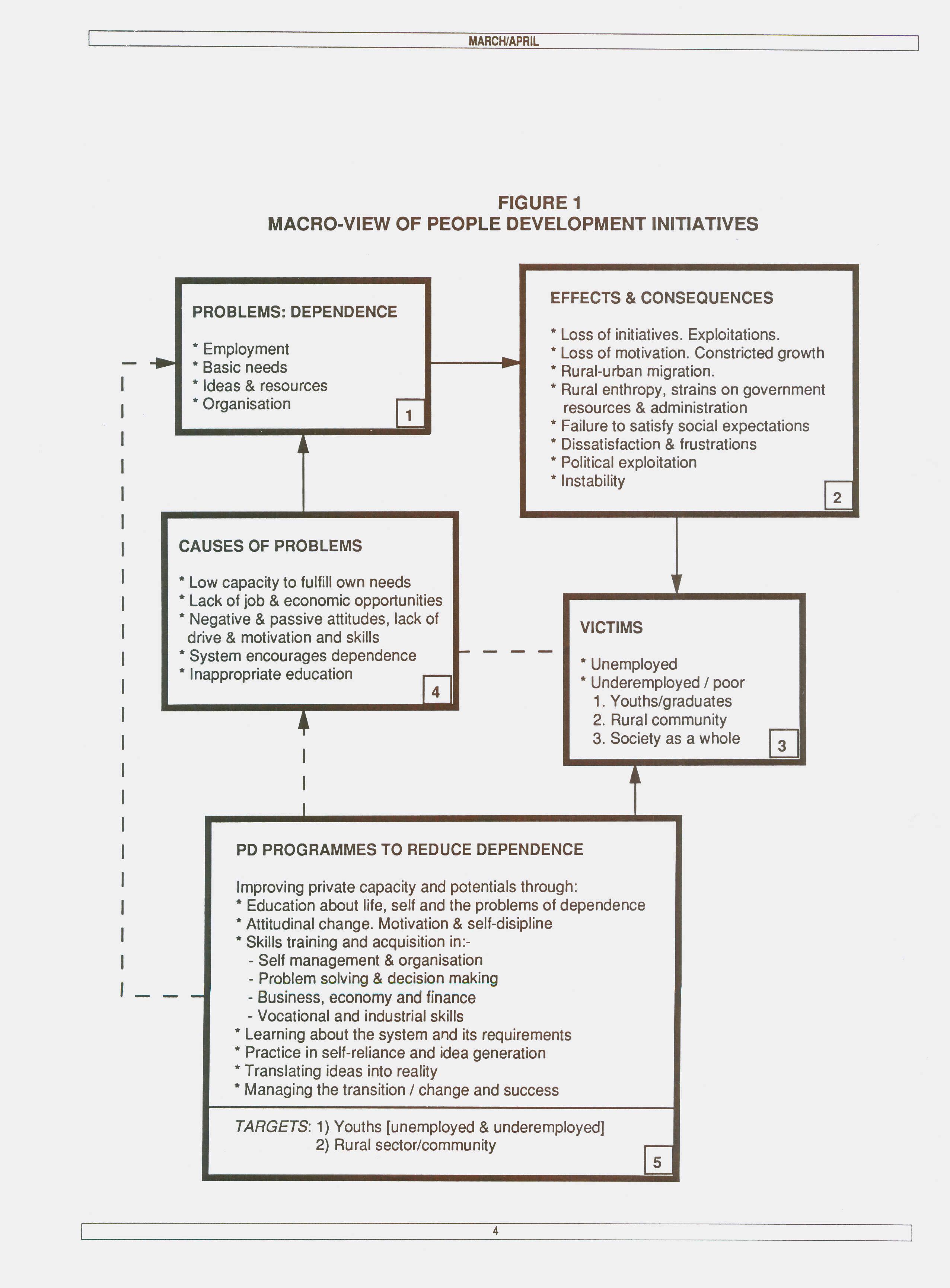
9 minute read
Datuk Dr. Jeffrey Responds to Questions on People Development
QUESTION 1 "POCatsandRMshavenotreallyunderstood the PO concept... they seem pressured by management to get projects up and going ... All these have caused deviation of the PO concept which emphasised people and not projects... "
DATUK DR. JEFFREY: The above observation does not show that POCats and RMs do not understand the PO concept, but rather Management does not. It seems to me that there is a problem of '" expectations here - the expectation by Management that PO Cats produce. The question is what does Management expect the facilitators and catalysts to produce? Projects? Profits? Jobs? If so, then this is the wrong expectations. Projects, incomes andjobs areproducedbythePOPparticipants for themselves with the help and guidance of the catalysts. The job of the PO Cats is to open upthe mental eyes ofthe participants to see, realise and accept their responsibilities and to provide them the tools (skills and knowledge) and keys to start their own engines so that they can proceed to move on their own. Attitudinal change is one of the most important tasks to be accomplished by the catalysts/facilitators but ttis not the only important task. Motivation (achievement motivation), the development of selfawareness andconsciousness, the imparting of skills, etc. are just as important.
Myviewisthat managementalsounderstands the PO concept but tt is being influenced by ttsold stereotype thinking by usingthe wrong yardstick to measure the results of PD. Perhaps, management is "afraid" of what others might say, including the BOT, unless the results are visible and quantifiable. This, to me, might be the explanation. In addition, there are prizes/awards to be won ifone can produce more tangible results. Well, compe1ttionsinthismannerdo notnecessarily cause a deviation in the implementation of the POconcept. After all if PO Cats do their job well in preparing/transforming their participants into a new level of awareness, desire, commitment and discipline, the chances for the latterto dowell inproducing tangible results are greater than otherwise.
QUESTION 2 "Government Agencies are reluctant to go into a village, where there are already PO programs.... no need for them to come in."
DATUK DR. JEFFREY: Onthecontrary,wherethere isaPOprogram the assistance and role of government agencies are allthe more required because we need to work together to achieve progress. YS is only a catalyst. It helps to bridge the demand and supply of government programs and assistance. The agencies have the expertise (e.g. Agriculture). We function as a channel for them to perform their extension services. As to moving into villages, I am against community development as a priority. We should have a specific target group - the youths. (See Figure 1 on page 4).
QUESTION 3 There is a confusion between "PO" and" PO program" ?
DATUK DR. JEFFREY: There is no confusion here. PO or People Oevelopment is the approach, the way or method or strategy based on its concept to cause development. In order to make this happen we must have a program to deliver or implement. Therefore, PO and POP are two different things.
QUESTION 4 "PO is YS, YS is PO" versus "YS is only the catalyst, coordinator; complementing and supplementing .... " is a paradox?
DATUK DR. JEFFREY: No, it is not a paradox. When we say "YS is only the catalyst, coordinator, complementing, etc.. " we are referingtothe roleofYS inrelationto the State andFederal Governments and their agencies inbringing development and servicing the needsofthe people inthe State. PO is ourtool, ourway, our strategy, our contribution to that role.
In addition to the above, below is an added explanation to further enhance understanding of the PO concept. It gives a macroview of PO initiatives from another angle.
THE PROBLEM IN PERSPECTIVE As shown in the diagram on Figure 1 the problem that we are trying to address in people development isthe problem of overdependence especially society's dependence on the government for the provision of employment (especially to the youths, graduates), for basic needs (especiallythe poor)andfor ideas,resources and the organisation to deliver these needs (Box 1). Our concern is that ifthis problem is not addressed, there will be grave consequences on society (Box 2) and the individuals who are victims of dependence (BOX 3) especially the unemployed and the rural communities.
Inorder to address this problem (Box 1),we must identify and deal with the root causes ofthe problemofdependence (Box4). These include the lack of economic stimulation in the rural areas, the under- developed capacity of the individuals and potentials to participate effectively in the mainstream of society, human obstacles such as negative and passive attitudes towards life, lack of
motivation and skills to do things for themselves and to progress; internalisation of dependence as a way of life due to the existing system and to political competitions; and because of the incompleteness or inappropriateness of our present education.
After studying the weaknesses of the present system its programs and approaches which puts emphasis in giving projects, one-sided administration, imposition to change, lack of cultural sensitivity, low commitment and pride in serving, lack of follow-ups, etc., YS has 3. come up with a new approach called People Development which focuses on the people itself. The idea is to help the individuals, particularly the victims of dependence to increase their capacity for self-reliance through their own ideas and efforts by assisting them in realising and accepting responsibilities for their problems; guiding them in overcoming these problems and 5. giving them the knowledge and skills required to generate ideas and projects of their own. Based on the PD concept and on the above, specific programs called People Development Program (PDP) have been developed for implementation (Box 5).
TARGET GROUP AND PDP OBJECTIVES In implementing the people development programmes, we must have a specific target group and specific objectives.
The target groups of the PDP are mainly the youths who are unemployed or underemployed (graduates or dropouts). While our aim is to transform society so that II is able to cope effectively with modernisation and change, we must have a vehicle or agent for such change. Itwould be difficult to target the whole community because ofthe coverage and resources required. Thus, the youths are the appropriate vehicle or agents for such transformation. The reasons are as follows:-
The young people/graduates are the ones likely to be unemployed and dependent on the government or the system togive them employment. They are avulnerable group in life's transition who have nowhere to go. Ifthey remain at home they will be dependent on their parents and become a burden. If they leave they will cause rural-urban drift develop. At the same time, they will cause unemployment congestion in the urban areas and subject themselves to all kinds of exploitations and abuses.
The youths are more educated than their parents and their minds are still receptive to changes and suggestions. This will make it easier to teach, train and change them than their parents.
As the parents grow old, the youths will take over their role as parents. Thus, we are targeting the replacements whose demands are emerging. They are the future. Let us deal with them now. If we target the community of parents, our problems will not be addressed. Targeting the youths inthe community does not deprive us of the opportunity to work with the community, including children and their parents but it does give us a specific focus. It is my observation that we are moving in the wrong direction by targeting the community as a whole. Many government agencies already exist to deal with them directly. Let us not duplicate their work or programs. Targeting kampongs and communities will not only require a lot of human and financial resources but it will take a lot longer to achieve results with a slim chance of permanent change. Our presence in the community will soon create dependence which we came to eliminate. This may be the reason for the condition in Talangkai as an example. We should have learned from our pilot projects. Come to think of it, I have never really known or received the conclusive assessment of the community-based pilot projects but I know what happened in the Tambunan youth pilot project. My observations and findings are documented in the book "People Development, The YS Experience 1990". The strategic objectives of PO have been laid down and discussed in the concept paper and elsewhere. The mechanism for

depriving the rural sector the brains implementation as well as the approaches
paper and elsewhere. But what Iwould like to comment on further are the following issues:-
(a) "People versus Project" issue and the observations that (b) "PD Cats and RMs seem pressured by Management to get projects up and going"
Management must realise that the goal of People Development is to free people from the cycles of problems caused by over dependence by showing them what, who, why and how. It is not for us to ~ them projects. The participants of the PDP must come up with their own ideas and projects (with your help) when they are ready. They will be ready QIlOC when they have fully understood and accepted responsibility for their own life, are fully equipped to cope with their immediate and future problems and are motivated to change their destiny and improve their conditions in life. Our task is to help and guide them - to show them the way so that they can proceed on their own. Do not put the cart before the horse by thinking and worrying about projects. If you do this, your mental preoccupation will rob you of your effectiveness in implementing what is really important: the preparation.
Successful implementation of the PD concept results in the transformation of the individuals into new persons with positive attitudes and outlook on life and with new zeal of life, able to make decisions, solve problems and cope with life. He or she will have the commitment and discipline to succeed or to turn a failure into a success, maintain that success and keeps on improving his/her conditions of life. A successful PD participant can cope with life and succeed wherever he/she is located. As all actions originate in the mind, success and failures are also born here. Thus, people development is aprocess to develop the mind.
EDITOR'S NOTE: This article is an excerpt of Datuk Dr. Jeffrey's response to a letter from Group Manager, Public Affairs
FIGURE 1 MACRO-VIEW OF PEOPLE DEVELOPMENT INITIATIVES
* Employment * Basic needs * Ideas & resources * Organisation
* Low capacity to fulfill own needs * Lack of job & economic opportunities * Negative & passive attitudes, lack of drive & motivation and skills * System encourages dependence * Inappropriate education * Loss of initiatives. Exploitations. * Loss of motivation. Constricted growth * Rural-urban migration. * Rural enthropy, strains on government resources & administration * Failure to satisfy social expectations * Dissatisfaction & frustrations * Political exploitation * Instability

* Unemployed * Underemployed / poor 1. Youths/graduates 2. Rural community 3. Society as a whole
Improving private capacity and potentials through: * Education about life, self and the problems of dependence * Attitudinal change. Motivation & self-disipline * Skills training and acquisition in:- Self management & organisation - Problem solving & decision making - - - Business, economy and finance - Vocational and industrial skills * Learning about the system and its requirements * Practice in self-reliance and idea generation * Translating ideas into reality * Managing the transition / change and success
TARGETS: 1) Youths [unemployed & underemployed] 2) Rural sector/community




